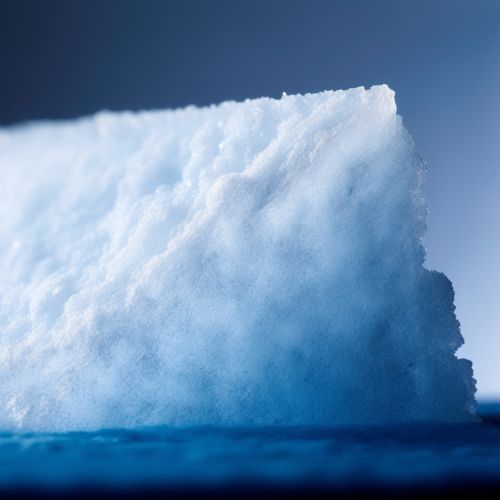Silica Aerogel
Introduction
Silica aerogel is a synthetic porous ultralight material derived from a gel, in which the liquid component for the gel has been replaced with a gas. The result is a solid with extremely low density and low thermal conductivity. It is noted for its excellent insulating properties and has been used in a variety of applications from insulation for buildings to components for space exploration.
History
The first aerogels were produced from silica gels by Samuel Kistler in the 1930s. Kistler's method involved the replacement of the liquid in the gel with a gas under high pressure and temperature, a process known as supercritical drying. This allowed the liquid to be slowly drawn off without causing the gel structure to collapse from capillary action, as would happen with conventional evaporation. The first aerogels were made using silica, a material still used for most aerogels today.
Structure and Properties
Silica aerogels are composed of a network of interconnected nano-sized particles or polymeric chains. The size of these structures typically ranges from 2 to 5 nanometers, and they are interspersed with pores of a similar size. This gives the material its characteristic low density, typically around 0.020 g/cm^3, although values as low as 0.001 g/cm^3 have been reported.
Silica aerogels also exhibit very low thermal conductivity, in the range of 0.013 to 0.020 W/m·K, which makes them excellent insulators. This property, combined with their low density, has led to their use in a variety of applications where weight and insulation are critical factors, such as in the aerospace industry.
Production
The production of silica aerogels begins with the creation of a silica gel. This is typically achieved by the hydrolysis and polycondensation of a silicon alkoxide, such as tetramethyl orthosilicate (TMOS) or tetraethyl orthosilicate (TEOS). The resulting gel is then subjected to supercritical drying to remove the liquid component and leave behind the aerogel structure.


Applications
Due to their unique properties, silica aerogels have found use in a wide range of applications. One of the most common uses is as a thermal insulator, where their low thermal conductivity and low density make them ideal for applications such as insulating buildings and industrial equipment.
In the aerospace industry, silica aerogels have been used for thermal insulation in spacecraft, including the rover vehicles used to explore the surface of Mars. They have also been used in the construction of the Stardust spacecraft, where they were used to capture dust particles from the comet Wild 2.
Silica aerogels are also being investigated for use in drug delivery systems, due to their ability to encapsulate and release drugs in a controlled manner.
Future Developments
Research into silica aerogels is ongoing, with scientists exploring new production methods and applications for this versatile material. One area of interest is the development of flexible aerogels, which could open up new possibilities in areas such as wearable technology and flexible electronics.
